Top News
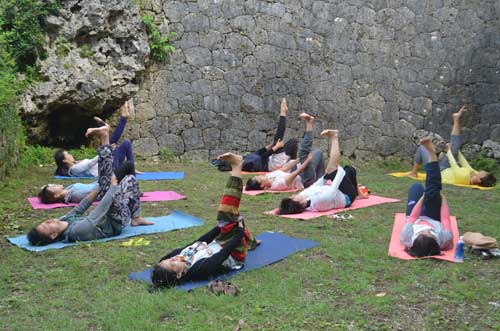
September 2, 2015 Ryukyu Shimpo
On August 29, a Yoga event, “Yoga in Amamikiyo”, was held at the ruins of Chinen Castle in Nanjo. Participants stretched in a relaxed manner, while being healed by the sounds of birdsong, and a breeze that rustled the trees around the ruins.
This event was held as a part of Nanjo City’s wellness events program. It was the first time it has been held at the ruins of the Castle.
The site of the ruins is located in the Chinen forest area, nearby one of seven utakis (sacred places) of Goddess Amamikiyo, the creator of the Ryukyus, who built the shrine when she descended from heaven.
Before the yoga session started, Junko Oshiro, a member of the Nanjo City Guide Amamikiyo Roman no Kai, told participants the story of the ruins and sacred places, including Mi Gusuku (new castle), Ku Gusuku (old castle), Tomuinutaki (central place of worship), in the Chinen Castle area.
Masako Hirano who took part in the event from Haebaru said, “I had a very good sweat while feeling natural energy from the sun, soil, and leaves.”
Yoga instructor Rui Tamaki said, “Okinawa’s ancient worship, in which people give thanks to ancestors, and yoga’s spirit, in which, people give thanks to nature and life, have something in common. The participants learned about the History of Okinawa from a guide. And so, they could face themselves deeply during the yoga practice.”
(English translation by T&CT and Hitomi Shinzato)
Go to Japanese
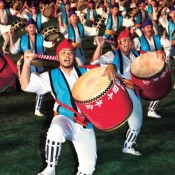
September 7, 2015 Ryukyu Shimpo
The 60th Okinawa Zento Eisa Festival, which is one of the largest Eisa events in Okinawa, was held at Koza Athletic Park in Okinawa City from September 4 to 6. Fifteen Eisa organizations from in and outside of Okinawa City, known as the “City of Eisa,” took part. Spectators were drawn to their lively performances.
Many spectators, both local Okinawans and international visitors, attended the event, with a total 320,000 people enjoying the festival over the three-day period, according to the event organizer. To bring the festival to a close, members of the Sonda Youth Group from Okinawa City performed a powerful Eisa dance. Traditional Eisa dances from various regions of Okinawa also enthralled spectators.
(English translation by T&CT)
Go to Japanese

September 4, 2015 Ryukyu Shimpo
A female green turtle, an endangered species, was found dead at Iji, Kunigami, after having laid eggs in Saipan. Sea turtles drifting 2,000 kilometers from Saipan to Japan is a rare event. A GPS satellite tag, attached to the turtle’s shell by National Oceanic and Atmospheric Administration (NOAA), enabled researchers to track the turtle. Such data on green turtles’ travelling routes and ecological system is rare and yet to be fully examined, so the finding is expected to be important for the protection of the species.
The green turtle’s body is considered large, with a width of 102.6 cm and a length of 76.8 cm. According to a confirmation from U.S. researchers in Saipan, the turtle laid eggs in Saipan on June 1, two and half months before the body was found on the beach in Iji. The cause and exact time of its death is unknown.
A member of the Sea Turtle Association of Japan, Muneyuki Kayo, who was contacted by the first person to discover the turtle, surveyed the body at the site with students from the Sea Turtle Research group at the University of the Ryukyus, confirming it to be the endangered turtle species. The body was temporarily stored with the Okinawa Churashima Foundation. Respecting the rights of the installers of the tag, the group will send it to NOAA after confirming the contact person in the States, who is expected to share findings after examining the ecological system of the species.
There is a record from November 2007 of two green turtles being captured by a trap net around Yomitan village after laying eggs in the Republic of Palau.
The Section Head of the Research Center at the Okinawa Churashima Foundation, Isao Kawazu, spoke of the importance of promoting exchange of information and accumulation of data with research institutions overseas. “If we don’t understand how green turtles move and how they live, we can’t understand how to protect them. It is increasingly crucial to keep data,” says Kawazu.
(English translation by T&CT and Sayaka Sakuma)
Go to Japanese
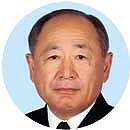
September 3, 2015 Ryukyu Shimpo
It recently came to light that on December 17-18 of last year, when Japan Self Defense Force Chief of Staff of the Joint Staff Council Katsutoshi Kawano visited the United States, he spoke to U.S. Marine Corps Commandant Joseph Dunford regarding the planned relocation of Marine Corps Air Station Futenma to Henoko. Kawano told Dunford that while a governor opposing the relocation of Futenma had been elected in Okinawa, the Henoko relocation issue was a matter to be discussed at the national government level, thus there would be no change in the Japanese government’s policy. He stated his expectation that the Abe administration would take a strong stance in moving forward with the project.
The emergence of this “promise” from the highest JSDF official to the U.S. regarding the Henoko relocation, being made immediately after Governor Takeshi Onaga took office on December 10 after campaigning on a platform of opposition to the new base construction, is likely to generate debate.

U.S. Marine Commandant Joseph Dunford
The discussion between Kawano and Dunford was noted in classified Joint Staff Office documents acquired by the Japan Communist Party. The documents were compiled on December 24, 2014, titled “overview of meetings by chief of staff during U.S. visit,” and were classified as “restricted.”
The documents contain details of Kawano’s meetings with numerous U.S. officials, including Dunford, Deputy Secretary of Defense Robert Work, Army Chief of Staff Raymond Odierno, Air Force Vice Chief of Staff Larry Spencer, Chief of Naval Operations Jonathan Greenert, Navy Staff Director Scott Swift, and Chairman of the Joint Chiefs of Staff Martin Dempsey.
In his meeting with Dunford, Kawano also made comments implying that the U.S. may have interfered in Okinawa’s gubernatorial election last year, thanking Dunford for his efforts in implementing the Liberty Policy (behavioral guidelines restricting U.S. service members, including a curfew and restrictions on alcohol consumption) and taking consideration of the local political situation at the time of the election.
Dunford expressed his desire to see the relocation plan carried out, stating that this kind of issue requires patience, and that it would be necessary to wait for a favorable turn in the situation.
In his meeting with Deputy Defense Secretary Work, Kawano played down opposition to the deployment of the U.S. Marine Corps vertical takeoff and landing aircraft, saying that it is only a minority of activists who are attempting to raise safety concerns about the MV-22 Osprey.
(Translation by T&CT and Sandi Aritza)
Go to Japanese
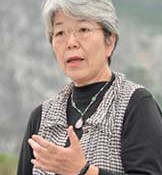
September 2, 2015 Ryukyu Shimpo
On September 3 at 6:30 p.m. at Mizu Plaza in Omoromachi, Naha, Etsuko Abe, an interim co-representative of the nationwide liaison council Opposition to Henoko Soil Hauling and co-representative of the Pan-Seto Inland Sea Congress, opened a meeting of the aforementioned liaison council. This council was established by a Naha citizens’ group performing activities at the excavation sites for soil to be used for the building of the replacement facility in Henoko. Abe says she will endeavor to collect signatures for a petition against soil hauling, and spread information about Henoko’s soil issues around Japan.
The nationwide liaison council established on May 31 has grown from a composite of 7 smaller organizations to a composite of 8. Additionally, Fukuoka and Kumamoto Prefectures both launched regional liaison councils, and there are citizens’ movements in Nagasaki and Kagawa Prefectures. Abe says approval of these activities is increasing. She says she wants to hear from people in Okinawa and keep an eye on the Diet proceedings as she prepares to submit the 43,000 signatures she has collected.
After inspecting each of the intended soil excavation sites, Abe emphasizes that although the dirt is being removed from unseen places, such as mountains, those places are essential to the people who live there. Furthermore, she points out that post-excavation, there is also the issue of industrial waste being buried at these sites. Common impressions within the opposition movement are that it is time for local people affected by Henoko issues to have another chance at receiving recognition, and that everyone desperately wants to avoid seeing their hometowns damaged.
Abe states that excavation in Goto City, Nagasaki Prefecture, and SDF force deployment problems in Amami Oshima, Kagoshima Prefecture, are related to Okinawa’s anti-war sentiment and the Henoko base. People living near soil excavation sites are made to be both aggressors and victims in these situations, she says, and all these issues are also related to nuclear power and the national government’s new security bills. She says she hopes to learn about Okinawa’s position from Okinawans. Then she plans to bring what she learns in Okinawa back to the people of the Seto Inland Sea region.
(Translation by T&CT and Erin Jones)
Go to Japanese
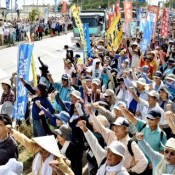
September 6, 2015 Ryukyu Shimpo
On September 5, a rally demanding the cancellation of construction of a new U.S. base in Henoko, the scrapping of a security bill and the resignation of the Abe administration was held in front of U.S. Marine Camp Schwab at Henoko, Nago.
According to the group of organizers, which includes the ruling party of the Okinawa Prefectural Assembly and citizen groups, about 3,800 people took part despite a heavy rain before and during the rally.
Hiroshi Ashitomi, co-representative of the Helicopter Base Objection Association, made a speech. He said, referring to the former Governor Hirokazu Nakaima’s approval of the landfill for the construction of the U.S. base, “Governor Takeshi Onaga should revoke his predecessor’s approval before his speech at the United Nations.” The governor is scheduled to speak at the UN in late September.
The participants showed their support for Ashitomi’s comments with applause and cheers.
They renewed their determination to stop the new base through the ‘All-Okinawa’ movement.
The fifth intensive consultation meeting between the governments of the prefectural and the central governments over the Henoko relocation issue was held in Tokyo on September 7. Ashitomi showed his determination to strengthen the sit-in protest in front of Camp Schwab, saying, “We will not allow the government to resume the construction work.” The participants gave him a big applause.
It is the fifth time such large rally has been held near Camp Schwab since the government started a seabed drilling survey last August.
Many citizens, including parents and children, took part in the rally. Members of the SEALDs RYUKYU, which is a youth group, also participated.
House of Representatives member Kantoku Teruya, a joint representative of the organizing committee, said, “We will win the struggle to protect the dignity of Okinawa and Uchinanchu (Okinawan people). We would like Govenor Onaga to cancel the former governor’s approval of the landfill as soon as possible.”
(English translation by T&CT)
Go to Japanese
September 8, 2015 Ryukyu Shimpo
The final meeting of the intensive consultations between the Okinawa Prefectural and the central governments over the plan to move U.S. Marine Corps Air Station Futenma to Henoko was held at 4:20 p.m. on September 7 at the Prime Minister’s Office.
The talks broke down with the governments unable to find any common ground or resolve the issue. They remain as far apart as ever.
Governor Takeshi Onaga said to Prime Minister Shinzo Abe and leaders of the central government, “I will exert every possible effort to block [the new U.S. base].” He showed his intention to cancel the former Governor Hirokazu Nakaima’s approval of the landfill in Henoko.
Chief Cabinet Secretary Yoshihide Suga told the governor that the government would resume the relocation work in Henoko after the prefectural government ends its diving survey in the sea off the coast of Camp Schwab.
The government suspended the land reclamation boring survey for one month. The central and the prefectural governments met for intensive consultations five times.
At the final consultation meeting, Prime Minister Abe asserted that the government was committed to removing the risks of the Futenma base, reducing the burden of the U.S. bases on Okinawa, and increasing Okinawa promotion measures.
The consultation was held behind closed doors, but media were allowed to take photographs at the beginning of the meeting.
Deputy Governor Mitsuo Ageda questioned the central government’s claim that the Henoko plan is the only option. According to the deputy governor, the then cabinet approved the initial Henoko plan on the condition that the government would build an airport for joint military-civilian use, but the then cabinet scrapped the plan in 2006.
Governor Onaga said, “I will respect as much as possible the conclusion that the third-party committee submitted.” He showed his intention to revoke the former governor’s approval of the landfill in Henoko, which the committee found was legally flawed.
After the meeting, the governor said, “I recognize the consultation has broken down.”
The chief cabinet secretary also said, “We have a consensus on the need to remove the risk and close the Futenma base. However, we could not fill a big gap between us in our methodological approach.” He expressed his intention to continue the dialogue.
Govenor Onaga refuted the prime minister’s claim that the government will reduce the base burden on Okinawa. “We have heard just the same story from then prime ministers and then ministers many times. I doubt they are going to solve this issue after 100 years,” Onaga said.
“When will the government’s promise be achieved? I am concerned that people who take it as truth will believe that the Abe administration is working hard for Okinawa. There will be no way for us to solve the issue. I have a strong belief that the government should not keep telling the same story,” Onaga said.
Prime Minister Abe, Chief Cabinet Secretary Suga, Foreign Minister Fumio Kishida, Defense Minister Gen Nakatani, Minister of State for Okinawa and Northern Territories Affairs Shunichi Yamaguchi, Deputy Chief Cabinet Secretary Kazuhiro Sugita from the central government and Governor Onaga, Deputy Governor Ageda from Okinawa attended the final consultation meeting.
(English translation by T&CT)
Go to Japanese

September 2, 2015 Ryukyu Shimpo
On August 30 at the Henoko Ground in the Henoko district of Nago City, a traditional tug-of-war event was held. Participants in the Henoko tug-of-war were divided into two groups, east and west, and faced off twice. The East group won the competition, after winning in the first attempt, and drawing in the second. The event was held for the first time in three years thanks to the efforts of an executive committee, a youth group, and associated groups. Despite rain pouring down in the middle of the event, about 2,500 people, more than the population of the district, turned out for the day and were psyched up for the tug-of-war.

The East team steadily pulled on the rope, winning the first match of the tug-of-war .
The event began with a performance by a band from the U.S. Marine Corps Camp Schwab. Calling “Wasshoi wasshoi,” a children’s group, a student’s group, and pupils from Yamabiko Kube Preschool, marched with a portable shrine. Parents smiled and waved at them.
During a traditional Eisa performance by the youth group, a heavy rain fell. However, performers persevered and kept dancing, the strong beat of the drums never stopping. Also on the stage that day, was a powerful performance of Bojutsu (martial arts with a stick).
Tebigae, a ceremony in which young men with a flaming torch run to form a circle, brought much excitement to the event. Residents and U.S. servicemen ran into the circle together, yelling “Sa sa sa” as they flicked fire spark off.
While the sound of shell trumpet and a blaring tritons trumpet worked up the crowd, a male rope and a female rope were linked with a Kanuchi stick, kicking off the tug-of-war. The East team steadily pulled the rope and won the first game. In the second match, neither side gave up and it ended in a draw.
After the tug-of-war, the district leader, who was also an executive committee member, Munekatsu Kayo, expressed his gratitude to the individuals and groups who helped make the tug-of-war event a success. He said, “In keeping with the symbol of the district, ‘Momentum’, I hope the people of the community will continue to work together in the future.”
(English translation by T&CT and Megumi Chibana)
Go to Japanese
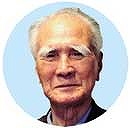
September 3, 2015 Ryukyu Shimpo
Honorary chairman of Social Democratic Party Tomiichi Murayama was the Prime Minister when a massive protest rally was held on October 21, 1995, following the 1995 rape of 12-year-old by U.S. servicemen. In December of the same year, Murayama sued then Okinawa Governor Masahide Ota, who was refusing to renew leases for American base land. As a result, landowners were forced to renew their leases. Murayama has since given an interview to the Ryukyu Shimpo. Murayama said he highly regards the “All-Okinawa” movement and called for revision of the Japan-U.S. Security Arrangements and Japan-U.S. Status-of-Forces Agreement.
Recalling his first meeting with Ota, which took place on November 4, 1995, and lasted four hours, Murayama said, “Okinawa has been sacrificed for the main island of Japan. Japan as the whole nation needs to tackle the U.S. military base issues.” He added, “The Japanese government should focus on diplomacy rather than preparing for wars. Murayama criticized the Abe administration, which is forcing through controversial security bills, saying, “Their logic is upside down.” He stated, “Japan needs to work on revising the Japan-U.S. Security Arrangements and Japan-U.S. Status-of-Forces Agreement.”
Murayama said he highly regarded the “All-Okinawa” movement, which he claimed had “emerged in accordance with the changes in the times.” However, he warned the situation would not change if the Abe government continues with its current approach. He stressed the need for the central government to change its policy of relying on military power to one that seeks peace. Murayama said, “The Okinawan people’s movement is making Japanese citizens rethink the current situation.”
(English translation by T&CT)
Go to Japanese
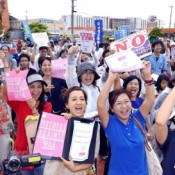
August 25, 2015 Ryukyu Shimpo
On August 23, at a park in Chatan, youth group SEALDs RYUKYU held a protest rally against the government’s security-related bills and the construction of a New U.S. base in Henoko, Nago. About 500 University students took part in the rally. They voiced their opposition, saying, “No War Bill” and “Protect Henoko”.
The rally was part of a nationwide event held in over 60 places in Japan on the same day. At the Okinawa rally, the Matsumoto Youth Eisa Group from Okinawa City performed eisa dance, and then the students chanted to a passionate rap, demanding the government cancel the security-related bills and the new Henoko base.
(English translation by T&CT and Hitomi Shinzato)
Go to Japanese
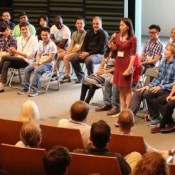
September 1, 2015 Ryukyu Shimpo
On September 1, The Okinawa Institute of Science and Technology Graduate University (OIST) held an enrollment ceremony for doctoral students at the school, which is located in the Tancha district of Onna. The fourth batch of students is made up of twenty-four newcomers from 15 countries. They are scheduled to study at the university for five years. At the ceremony, the OIST President Jonathan Dorfan said that he hoped they would become world leaders. He added that he wanted them to develop their research fields and work on global challenges.
Taiwanese Shea Tuinhan joined the university after working for seven years. Tuinhan, who majors in biology, said that he is grateful to OIST for giving him an opportunity to do research again.
Camira Mustafina who studies immunology and microbiology, is from Kazakhstan, which is landlocked. Mustafina said that she was excited to come to Okinawa, which has beautiful ocean scenery.
(English translation by T&CT)
Go to Japanese












 Webcam(Kokusai Street)
Webcam(Kokusai Street)


